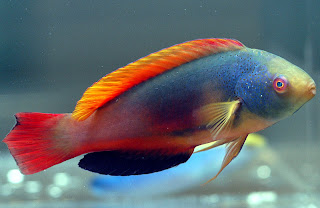The wrasse is a typically small species of fish, found in the coastal waters of the world's major oceans. The Cleaner wrasse is the most commonly known wrasse species as it is often seen alongside other marine animals, including sharks. There are more than 500 different species of Wrasse found in the shallower coastal waters and coral reefs,
of the Pacific, Indian and Atlantic oceans. Wrasse most commonly
inhabit areas that have an abundance of both food and places to hide,
making coral reefs and rocky shores the perfect home for the wrasse.
Cleaner wrasse are the most well-known wrasse species as they are often seen going into the mouths of large marine animals
in order remove the dead material inside. Cleaner wrasse feed on dead
tissues, scales and parasites that lurk inside the mouth of the larger
animal, and few are actually eaten by the predator that they are
assisting. Wrasse come in a variety of colours and sizes depending on
the species of wrasse. Wrasse tend to be relatively small in
size, with many species of wrasse being less than 20 cm in length. One
species of wrasse however is enormous in comparison, growing to more
than 2 meters long.
Wrasse are carnivorous animals
that have thick lips with a row of teeth that usually face outwards.
The mouth of the wrasse is protractile which means that it is capable of
extending forwards. Wrasse feeds on a number of small invertebrates,
small fish and food particles in the water. Wrasse are also known to
follow large predatory fish, eating the trail of left-overs that it
leaves behind it. Due to their small size, wrasse have numerous
predators in their natural environment including larger fish, such as
lionfish, dogfish and barracuda and wrasse are even eaten by some
smaller species of shark.
Wrasse are known to live for a
relatively long-time particularly for their small size. Wrasse mate by
releasing their eggs and sperm in to the water, which are fertilised and
become part of the plankton until they are big enough to join the reef.
Female wrasse lay thousands of eggs at at time so the wrasse population
numbers are relatively high. Source









0 comments:
Post a Comment